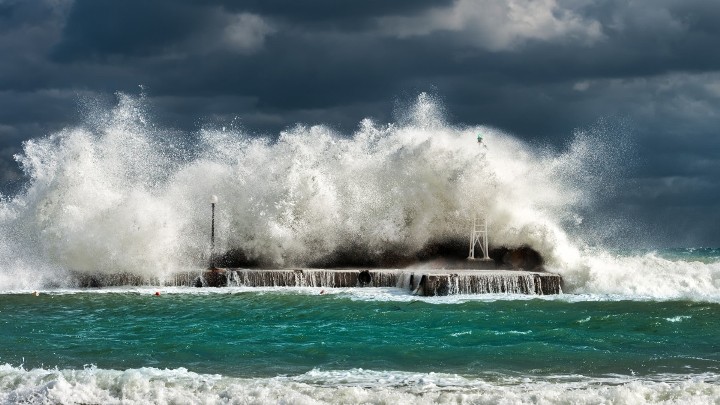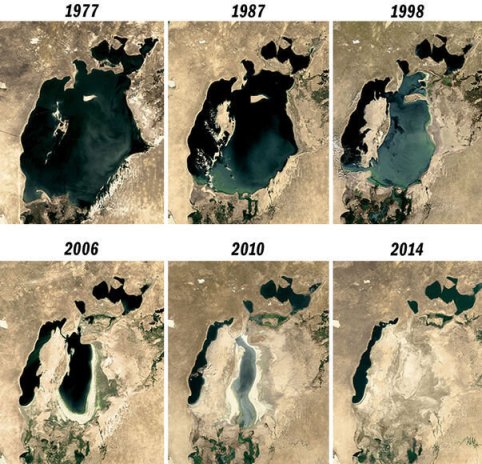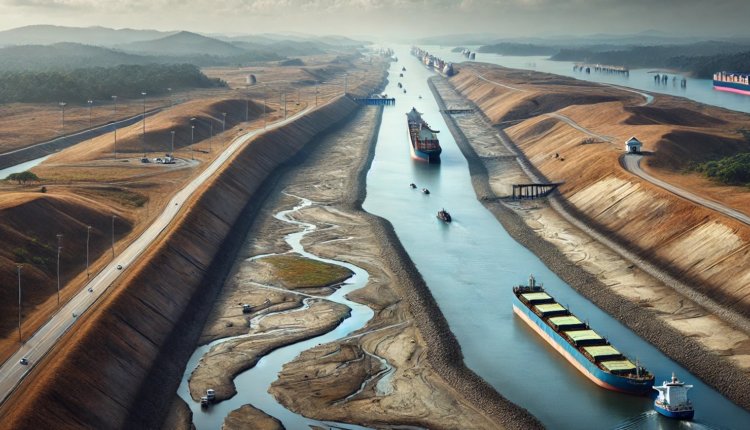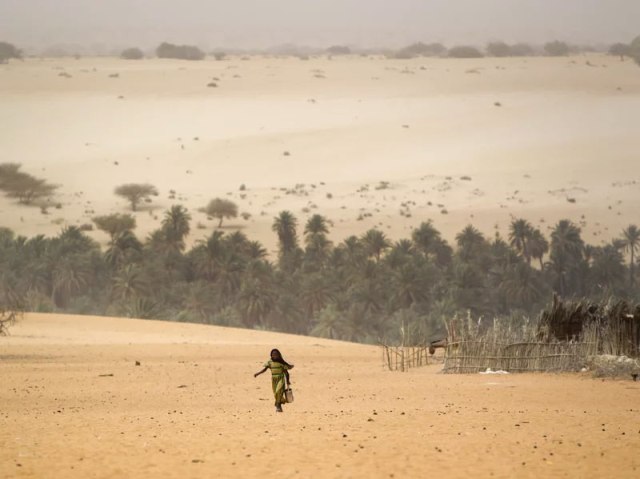Scientists have discovered the many faces of global warming: it not only accelerates the melting of glaciers, raising the level of the World Ocean, but also leads to seismic activity. Over the past 30 years, the amount of dust in Central Asia has increased by 7%. One of the reasons for this is the drying up of the Aral Sea. The Panama Canal Authority (ACP) said on Wednesday that the famous waterway continues to face a shortage of water.
Scientists have discovered the many faces of global warming: in particular, it not only accelerates the melting of glaciers, raising the level of the World Ocean, but also leads to seismic activity. Moreover, the “shakes” are recorded not only on land, but also on the ocean floor, reports the journal Natur Communications.
We are not talking about traditional earthquakes, but about seismic microwaves. They occur when the ocean sways violently, causing its waves to rise and then crash down with force, impacting the shores and the seabed, its bottom rocks. These impacts are recorded by sensitive seismic instruments as a stable noise, which scientists call global microseisms. As studies show, the global energy of ocean waves in the last twenty years of the last century increased by an average of 0.27% each year. In the current century, the average annual growth has increased to 0.35%!

Such seismic activity itself does not pose any threat, but it is a marker of events that can become catastrophic. The highest total microseismic energy was recorded in the Southern Ocean near Antarctica, and recently it has begun to increase sharply in the North Atlantic. All these are alarming signals. They mean that the World Ocean in the 21st century is “worried” more than before. Moreover, such an increase in the energy of ocean waves coincides with the intensification of storms on the planet.
The reason for all these phenomena, according to scientists, is global warming. Why? The explanation is as follows. For decades, the ocean has been “taking on” the attacks of global warming, absorbing a huge amount of excess heat and stabilizing the temperature on Earth. This stored energy requires an outlet. Which is what the ocean does, generating more and more powerful “energy-intensive” waves: they shake the Earth more and more strongly, increasing the destructive impact on the coastline and bottom rocks.
Over the past 30 years, the amount of dust in Central Asia has increased by 7%. One of the reasons for this was the drying up of the Aral Sea. This is the conclusion reached by German scientists from the Leibniz Institute for Tropospheric Research and the Free University of Berlin. As reported by Gazeta.RU, the report was published in the scientific journal Atmospheric Chemistry and Physics (ACP).
As the analysis showed, from 1984 to 2014, dust emissions from the desert that arose on the site of the reservoir almost doubled – from 14 to 27 million tons. Experts noted that the amount of dust could be significantly greater, since 2/3 of its volume remains in the air.
Until the early 1960s, the Aral Sea in Central Asia was the fourth largest lake in the world, covering 68,000 square kilometers, and was fed by the Amu Darya and Syr Darya rivers from the Pamir and Tien Shan mountain ranges. Due to overuse of the rivers for agricultural irrigation, less and less water entered the lake. As a result, large areas dried up, the lake shrank to a negligible size, and much of it turned into sand, known as Aralkum. Aralkum is considered one of the most significant man-made sources of dust on Earth. At 60,000 square kilometers, the desert is much smaller than the nearby natural deserts of Karakum (350,000 square kilometers) to the south in Turkmenistan and Kyzylkum (300,000 square kilometers) to the southeast in Uzbekistan and Kazakhstan. But the dust from Aralkum is considered much more dangerous, as it contains residues of fertilizers and pesticides.

To estimate the impact of dust from the Aralkum Desert, the team used the COSMO-MUSCAT atmospheric dust model, which estimates the concentration of particles in the atmosphere. On Earth, dust has a cooling effect during the day by obscuring sunlight, and a warming effect at night by reflecting long-wave thermal radiation from the surface. Thus, the net radiative effect of dust can be cooling or warming, depending on the height of the dust in the atmosphere, the time of day, the season, the reflectivity of the surface, and the precise mineralogical and optical properties of the substance.
In addition to radiative forcing, the researchers also found signs that dust can alter large-scale weather patterns: Aralkum dust increases ground-level air pressure in the Aral region by up to +0.76 Pascal on a monthly scale, which means a strengthening of the Siberian maximum in winter and a weakening of the Central Asian thermal minimum in summer.
The findings highlight that increasing desertification due to drying lakes is not just a local problem, but affects large regions. New data on the former Aral Sea helps to better assess the impact of desert dust on the climate.
The Panama Canal Authority (ACP) said on Wednesday that the famous waterway continues to face water shortages despite recent rains that have eased most of the restrictions imposed after last year’s drought.
“The waterway continues to be impacted by last year’s prolonged dry season, which limited the daily capacity of the canal,” the ACP said in a statement. “Despite the start of the rainy season, the water problem in Panama and its canal has not been resolved.”
Unlike other waterways such as the Suez Canal, the Panama Canal, through which about six percent of the world’s maritime traffic passes, runs on rainwater from the man-made lakes of Gatun and Alajuela.

The El Niño weather phenomenon last year forced the dry canal to reduce the number of ships passing through it each day and to reduce the draft allowed for ships.
However, the agency said on Wednesday that starting from July 11, ships’ drafts will be allowed to increase to 14.6 metres, and from August 5, a maximum of 35 ships per day will be allowed through the canal.
The ACP, which manages the canal, also called for identifying alternative sources of water and developing water storage projects.
In fiscal year 2023, 511 million tons of cargo passed through the Panama Canal, generating revenue of $3.34 billion.
The deadly heatwave that has swept across West Africa, flooding hospitals and morgues in parts of the region, would not have happened without human-caused climate change, according to a study by a network of international scientists. Extreme temperatures of over 110 degrees Fahrenheit likely killed hundreds or thousands of people in many countries in the region.
A new analysis by the World Weather Attribution group found that the region’s sharp rise in temperatures during the five-day heat wave would not have been possible without human-caused climate change, including fossil fuel burning and deforestation. Previous research has shown that excessively high nighttime temperatures can be particularly deadly because the body is unable to cool down and recover from daytime heat stress.
The five-day period from late March to early April was one of the most extreme on record, a once-in-200-year event that resulted in the Malian town of Kayes recording its hottest day ever in early April, with temperatures reaching 119 degrees Fahrenheit (48.5 degrees Celsius).

One hospital in Mali’s capital, Bamako, recorded 102 deaths in the first four days of April, close to the number recorded in the entire month last year. More than half of those who died were over 60, the hospital said, and the heat played a role in their deaths.
The death toll in the region is unknown, but local reports indicate unusually high mortality rates and that some morgues in Bamako are overflowing.
The deaths were also caused by power shortages in countries such as Nigeria and Sierra Leone, leaving people without fans and air conditioners. This exacerbated the risk for vulnerable groups and even those not usually considered vulnerable. It also coincided with Ramadan, a period of fasting for Muslims, the main religious group in the Sahel region of West Africa.
Temperatures rose to 1.5 degrees Celsius (2.7 F) above normal across the region, a critical point that causes mass casualties. Evenings brought little relief, with temperatures averaging 2 degrees Celsius (3.5 F).
The climate crisis has been particularly deadly in the Sahel region, exacerbating the shrinking grazing lands of pastoralists across the region. These problems have fueled mass migration in the region and jihadist insurgencies that have particularly engulfed much of Mali, Burkina Faso, and Niger.
The report concluded that such extreme weather events in the region will continue as the planet continues to warm.
Climate change, fueled by CO2 emissions, is poised to deal a devastating blow to the global economy, according to a new study published in the journal Nature. Its authors say the planet is facing a looming economic downturn, estimating that global GDP will shrink by about $38 trillion by 2050, or nearly a fifth of total global GDP.
The study highlights the grim reality that even with aggressive measures to reduce carbon emissions, the economic impacts of climate change are virtually inevitable. Max Kotz of the Potsdam Institute for Climate Research (PIK) stressed that failure to act quickly could lead to even more catastrophic economic consequences that extend beyond mid-century.
As the Earth’s average surface temperature continues to rise steadily, currently at a dangerous 1.2 degrees Celsius above pre-industrial levels, the consequences are becoming increasingly dire. Heat waves, droughts, floods and tropical storms, exacerbated by rising sea levels, are wreaking havoc across the globe, causing serious damage to both human life and economic stability.
The study’s projections paint a bleak picture of the future: by the end of the century, annual economic losses could amount to tens of trillions of dollars if global temperatures exceed a critical threshold of two degrees Celsius.
The researchers say the 2015 Paris Agreement’s key goal of limiting global warming to below 2 degrees Celsius remains within reach. They stress that the investment needed to achieve that goal pales in comparison to the catastrophic damage that could be prevented.
However, economists continue to debate the best approach to addressing climate change. While some advocate immediate and substantial investment, others advocate a more measured approach, citing the potential for future technological advances and increased social welfare.
Of particular concern are the implications for developing countries, which are disproportionately affected by climate change despite bearing minimal responsibility for its onset. The study concludes that these countries, already facing economic difficulties, are ill-prepared to weather the storm of economic shocks caused by climate change.




